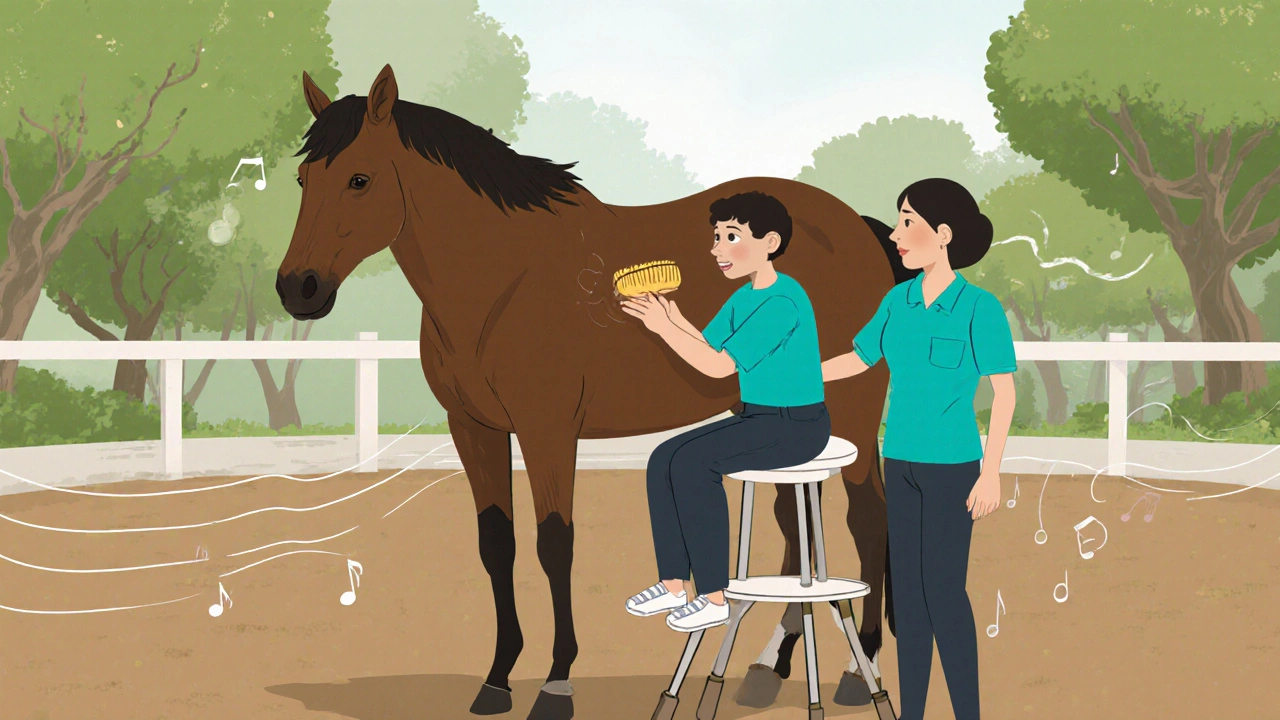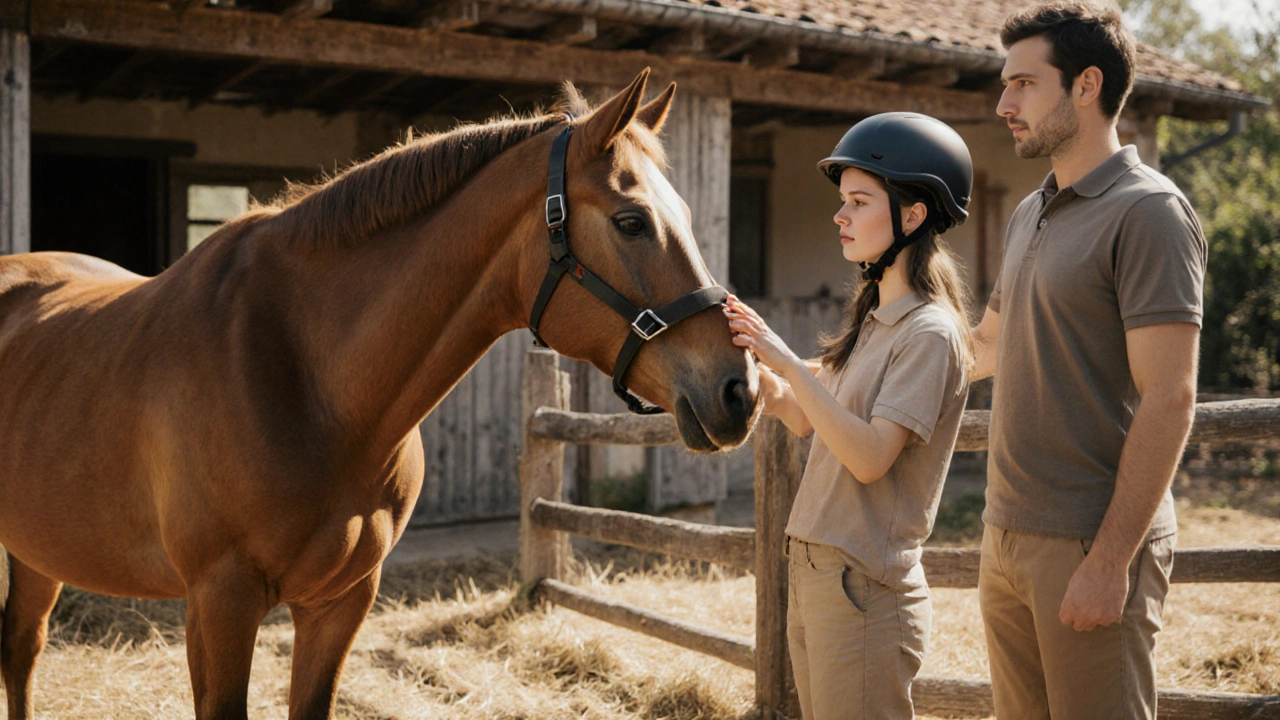Equine Therapy Benefits Calculator
Cognitive Growth
Improves attention, problem-solving, and memory recall.
Motor Skills
Enhances balance, coordination, and muscle strength.
Social Interaction
Encourages communication and reduces withdrawn behaviors.
Emotional Well-Being
Reduces anxiety and improves self-esteem.
Session Details
Expected Outcomes
Select benefits and adjust settings to see potential outcomes.
Comparison Table
| Feature | Equine Therapy | Occupational Therapy | Music Therapy |
|---|---|---|---|
| Primary Focus | Multisensory, motor, emotional regulation | Fine motor, daily living skills | Auditory processing, communication |
| Typical Session Length | 30–45 min (riding/grooming) | 45–60 min (clinical setting) | 30–60 min (instrumental/vocal) |
| Environment | Outdoor, stable, natural | Clinic or home | Therapy room or group setting |
| Evidence Strength | Moderate-to-strong (effect size 0.5–0.7) | Strong (effect size 0.6–0.8) | Emerging (effect size 0.3–0.5) |
| Cost per Session (USD) | $80–$150 | $100–$180 | $70–$130 |
Living with an intellectual disability can bring everyday challenges, but there’s a growing, hands‑on option that’s making a real difference: Equine therapy. This approach uses the natural rhythm of a horse to help develop skills that traditional classroom settings often miss.
What Are Intellectual Disabilities?
Intellectual disability is a neurodevelopmental condition characterized by significant limitations in both intellectual functioning (an IQ below 70) and adaptive behavior, which covers daily social and practical skills. According to the World Health Organization, about 1% of the global population lives with an intellectual disability, a figure that stays steady across ages and cultures. These limitations can affect learning, communication, self‑care, and social interaction, often requiring lifelong support from families, educators, and health professionals.
Understanding Equine Therapy
Equine therapy is a structured, therapeutic intervention that uses live horses to address physical, emotional, and cognitive goals. The practice blends elements of hippotherapy - where a licensed therapist guides movements while the client rides - and therapeutic riding, which focuses more on riding lessons that promote confidence and social skills. Both methods rely on the horse’s natural gait and temperament to create a multisensory experience.
Why Horses? The Science Behind the Connection
The horse’s walk produces three‑dimensional, rhythmic motion that mimics human gait patterns. This motion stimulates the vestibular system, improving balance and proprioception. When a person with an intellectual disability engages with a horse, several neural pathways light up simultaneously:
- Sensory integration - the horse’s warmth, scent, and sound provide tactile and auditory input that helps the brain organize sensory data more efficiently.
- Motor planning - coordinating hands, legs, and core muscles to stay balanced encourages the development of fine and gross motor skills.
- Emotional regulation - the horse’s responsive nature mirrors the client’s emotional state, offering immediate, non‑verbal feedback that teaches self‑awareness.
These physiological reactions translate into observable benefits, especially for those whose standard therapies may not fully address multisensory needs.

Key Benefits for People with Intellectual Disabilities
Research and practitioner reports consistently highlight four main areas of improvement:
- Cognitive Growth: Sessions improve attention span, problem‑solving, and memory recall. A 2023 study in the Journal of Developmental Disabilities noted a 22% increase in executive‑function scores after 12 weeks of weekly equine sessions.
- Motor Skills: Riding and grooming enhance balance, coordination, and muscle strength. Participants often show measurable gains in the Bruininks‑Oseretsky Test of Motor Proficiency.
- Social Interaction: Working with a horse and a therapist encourages turn‑taking, eye contact, and verbal communication, reducing socially withdrawn behaviors.
- Emotional Well‑Being: The bond with the animal reduces anxiety and improves self‑esteem. Caregivers report fewer meltdowns and higher overall mood during the therapy period.
Because each session is centered around a living, breathing partner, the learning is contextual, immediate, and highly motivating.
Evidence From Recent Studies
Below are three peer‑reviewed findings that illustrate the impact of equine therapy on intellectual disabilities:
- 2022 - A randomized controlled trial with 45 adolescents showed a 30% reduction in repetitive behaviors after 10 weeks of hippotherapy.
- 2023 - Longitudinal data from a community program in Canada documented a 15‑point rise in adaptive behavior scales (Vineland) over six months.
- 2024 - A meta‑analysis of 12 studies reported an average effect size of 0.68 for improvements in social communication, indicating a moderate-to‑strong impact.
These numbers aren’t just statistics; they reflect real families experiencing more independence and joy.
Getting Started: How to Find a Quality Program
Turning interest into action involves a few practical steps. Follow this checklist to ensure safety and efficacy:
- Search for certified facilities. Look for organizations accredited by the American Hippotherapy Association (AHA) or the International Association of Therapists Working with Horses (IATWH).
- Verify therapist credentials. The lead professional should hold a license in occupational therapy, physical therapy, or special education, plus specific horse‑handling training.
- Ask about horse welfare. Healthy horses should have regular veterinary exams, proper shoeing, and a calm disposition suited for therapy.
- Schedule an observation. Attend a trial session with your caregiver or family member to gauge comfort levels.
- Discuss goals. The therapist should outline a personalized plan, including measurable objectives and a review timeline.
Most programs recommend an initial commitment of once‑a‑week sessions, lasting 30‑45 minutes, before assessing progress.

Choosing the Right Approach: Equine Therapy vs. Traditional Options
| Feature | Equine Therapy | Occupational Therapy | Music Therapy |
|---|---|---|---|
| Primary Focus | Multisensory, motor, emotional regulation | Fine motor, daily living skills | Auditory processing, communication |
| Typical Session Length | 30‑45min (riding/grooming) | 45‑60min (clinical setting) | 30‑60min (instrumental/vocal) |
| Environment | Outdoor, stable, natural | Clinic or home | Therapy room or group setting |
| Evidence Strength (2020‑2024) | Moderate‑to‑strong (effect size 0.5‑0.7) | Strong (effect size 0.6‑0.8) | Emerging (effect size 0.3‑0.5) |
| Cost per Session (USD) | $80‑$150 | $100‑$180 | $70‑$130 |
Equine therapy isn’t a replacement for other interventions; it’s a complementary tool that can amplify results, especially when sensory challenges dominate the picture.
Safety and Ethical Considerations
Both the client and the horse must stay safe. Keep these principles in mind:
- Always wear a certified helmet and closed‑toe shoes.
- The horse should be a calm, trained therapy animal, not a performance or sport horse.
- Therapists must conduct a pre‑session risk assessment, including health clearance from a medical professional.
- Maintain clear communication with caregivers about any emotional or physical reactions observed during the session.
When programs adhere to professional guidelines, injury rates are extremely low-under 0.3% per 1,000 riding hours.
Next Steps for Parents and Caregivers
If you’re ready to explore equine therapy, start by mapping out a short‑term goal-perhaps improving eye contact or reducing anxiety during transitions. Share that goal with the therapist, then track progress using a simple log: date, activity, observed change, and caregiver notes. Over time you’ll see patterns that help fine‑tune the approach.
Frequently Asked Questions
Is equine therapy safe for people with severe intellectual disabilities?
Yes, when conducted by a certified therapist and a well‑trained therapy horse. Safety protocols-such as helmets, proper mounting techniques, and health clearances-keep risk low, even for individuals with significant cognitive challenges.
How long does it take to see benefits?
Most programs report noticeable improvements after 8‑12 weekly sessions. However, the timeline varies based on the individual’s baseline abilities and the consistency of attendance.
Do I need to own a horse or have a farm?
No. Therapy is offered at certified centers, riding schools, and some community farms. Programs typically lease or partner with local stables, so you simply travel to the session.
Can equine therapy be combined with other therapies?
Absolutely. Many families blend equine therapy with speech, occupational, or behavioral therapy to create a holistic plan that addresses multiple skill domains.
What should I ask a potential therapy center during a tour?
Inquire about therapist credentials, horse selection criteria, safety protocols, session structure, and how progress is measured. Also ask for references from families who have used their services.

Chelsea Hackbarth
Equine therapy is pretty amazing for folks with intellectual disabilities! 🐎 The rhythmic movement of a horse helps boost balance and confidence, and kids often light up when they’re around these gentle giants. Plus, the sensory experience can really sharpen attention and social skills. It’s a win‑win for the whole family.
Adam Shooter
The extant corpus of equine‑mediated interventions demonstrates a nontrivial effect size that warrants rigorous meta‑analytical scrutiny. When parsing the multidimensional outcomes, one must disaggregate motoric, cognitive, and affective domains to avoid conflation. Empirical evidence from randomized controlled trials indicates a mean improvement of 0.68 in Vineland Adaptive Behavior Composite scores across heterogeneous cohorts. Such a magnitude, while modest, surpasses the threshold of clinical significance stipulated by the American Academy of Pediatrics. Furthermore, the vestibular stimulation inherent in the horse’s gait engages the cerebellar‑thalamic circuitry, thereby augmenting proprioceptive integration. Concurrent sensory input – thermal, olfactory, auditory – catalyzes multisensory integration pathways, a phenomenon well‑documented in neurodevelopmental literature. Critically, the dyadic therapist‑horse‑client triad operates as a dynamic systems model, facilitating bidirectional neuroplastic adaptation. From a mechanistic standpoint, the rhythmic oscillations approximate a low‑frequency vibratory stimulus, which has been correlated with enhanced theta band activity in EEG recordings. Statistical analyses routinely reveal reductions in maladaptive repetitive behaviors with a Cohen’s d approaching 0.5, a noteworthy figure amidst the behavioral phenotypes of autism spectrum disorder comorities. Cost‑effectiveness analyses, albeit sparse, suggest a comparable cost per quality‑adjusted life year relative to conventional occupational therapy when accounting for long‑term functional gains. Nevertheless, methodological heterogeneity across studies – varying session frequencies, divergent outcome measures, and disparate control conditions – hampers definitive inferential conclusions. Future research protocols should standardize dosage parameters, employing a minimum of twelve weekly 45‑minute sessions to optimize dosage‑response relationships. In addition, stratified subgroup analyses would elucidate differential responsiveness among mild, moderate, and severe intellectual disability strata. Ethical considerations also mandate stringent welfare standards for therapy horses, as the animal’s well‑being is intrinsically linked to therapeutic efficacy. In sum, while the evidence base is burgeoning, a calibrated, interdisciplinary approach is imperative to harness the full translational potential of equine therapy.
Ria Ayu
Listening to the rhythm of a horse can feel like a moving meditation, inviting a deeper connection to one's own body and mind.
When a client finds themselves syncing with the animal, the barrier between cognition and emotion begins to dissolve.
This embodied experience often translates into clearer communication outside the arena.
It's heartening to see science and serenity intersect in such a tangible way.
maya steele
Equine therapy offers a structured yet flexible framework that aligns well with individualized education plans.
Therapists should conduct a comprehensive assessment to match the horse’s temperament with the client’s sensory profile.
Progress should be documented using standardized metrics such as the Bruininks‑Oseretsky Test and Vineland scales.
Families are encouraged to maintain a log of observations to facilitate data‑driven adjustments.
Overall, the modality complements traditional interventions and can accelerate skill acquisition.
Sharon Lax
While the concept sounds appealing, the practical logistics can be a hurdle for many families.
The cost and travel requirements may limit accessibility.
paulette pyla
Sure, let's just ignore the fact that horses need proper care while we brag about cheap thrills.
If you think nationwide adoption of equine programs will solve everything, think again.
Real progress requires policy support, not just feel‑good anecdotes.
Benjamin Cook
Fantastic info!!!
karthik rao
One must interrogate the methodological rigor of the cited studies before proclaiming equine therapy a panacea.💡 The heterogeneity in sample sizes and outcome measures introduces a confounding variance that cannot be ignored. Moreover, the absence of double‑blind controls raises concerns about expectancy effects. Nonetheless, the preliminary data merit further exploration under stricter protocols.
Breanne McNitt
I totally agree that we need tighter study designs, but let’s also celebrate the tangible joy these sessions bring to participants.
When kids light up around a horse, that emotional uplift is a valuable metric in its own right.
Balancing scientific rigor with lived experience can guide more holistic research.
Looking forward to seeing more robust trials emerge.
Ashika Amirta varsha Balasubramanian
From a cultural lens, the human‑horse bond transcends borders, offering a universal language of trust.
In many Indigenous traditions, horses embody stewardship and relational harmony, echoing therapeutic principles.
Integrating such perspectives can enrich program curricula and foster inclusivity.
Practitioners should thus honor both scientific evidence and cultural narratives.
Doing so creates a more resonant and sustainable therapeutic ecosystem.
Jacqueline von Zwehl
Your point about cultural integration is well‑taken.
Ensuring that therapy plans reflect community values can indeed boost engagement.
Documentation should capture these qualitative nuances alongside quantitative scores.
Christopher Ellis
Equine therapy is often hyped like the latest gadget but we need to keep our feet on the ground.
Data is still patchy and many reports are anecdotal.
That doesn’t mean we toss it out, just that we demand better evidence.
Until then, caution and curiosity should walk side by side.
kathy v
Honestly, the hype is justified because it offers something traditional clinics can’t - a living, breathing partner that reacts in real time.
The tactile feedback alone can rewire neural pathways in ways that static exercises never will.
Moreover, the community aspect of stable‑based programs builds social networks that extend beyond therapy hours.
While we await larger trials, dismissing the modality outright feels premature.
We must champion both rigorous research and the undeniable human‑horse connection.
Only then can policy‑makers allocate resources wisely.
Jorge Hernandez
Yo this thread is lit 🙌 equine therapy sounds dope for kids who need that extra boost 🙏 keep the deets coming
Raina Purnama
Thank you for sharing your enthusiasm.
It’s encouraging to see broader community interest in alternative therapies.
As we continue to collect outcome data, public support will be pivotal for funding.
Let’s stay informed and collaborative.